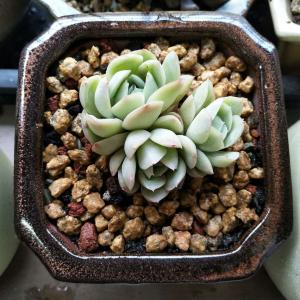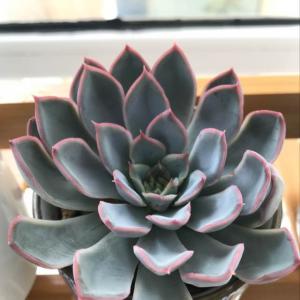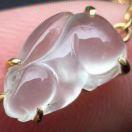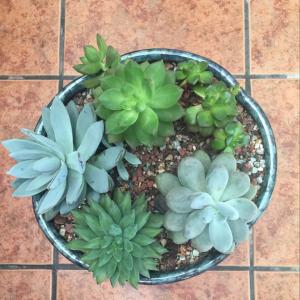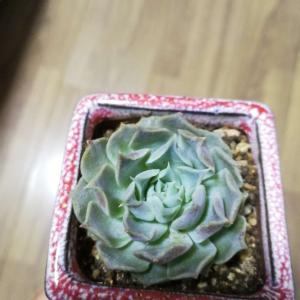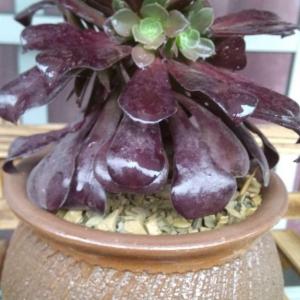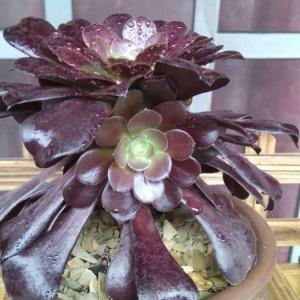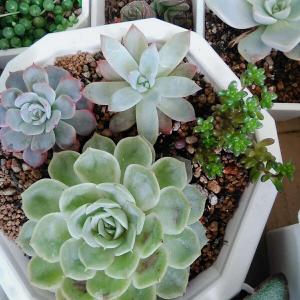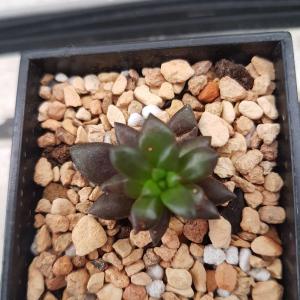文章
Miss Chen
2018年03月31日

Description: This herbaceous perennial plant is 2-4' tall and usually unbranched, except near the apex where the flowers occur. The central stem is light green, round, and usually hairless. Sometimes fine purple streaks occur along the stem. The opposite leaves are up to 6" long and 1" across. They are narrowly ovate or ovate-oblong, with smooth margins and conspicuous pinnate and secondary venation. The margins are slightly ciliate, otherwise the leaves are hairless. The lower leaves have short petioles, while some of the upper leaves may be sessile and rounded at the base.
The central stem and a few secondary stems near the apex of the plant terminate in rather flat-headed or gently rounded panicles of flowers. These flowering stems (peduncles) are often finely pubescent. The individual flowers are about 1" long and ½–¾" across, and can occur in a variety of colors, including bright rosy pink, lavender, and white. Each flower has a long tubular corolla with 5 spreading petals that are well-rounded and overlap slightly. The tubular calyx is green (sometimes with purplish tints) and much smaller than the corolla. The teeth of this calyx are long and narrow. Sometimes the calyx is pubescent or hairy. The blooming period occurs from mid- to late summer and lasts about 1½ months. The flowers are quite fragrant. The small seed capsules have 3-cells and are oval in shape. Each cell usually contains 2 small seeds. The root system consists of a taproot. Small clumps of plants are often formed.
Cultivation: The preference is partial sun, moist conditions, and fertile loamy soil. Light shade is tolerated, but flowers will be produced less abundantly. In full sun, the leaves have a tendency to turn yellowish green and the plants are in greater danger of drying out. Sometimes the leaves are attacked by various kinds of foliar disease, such as powdery mildew. This appears to occur less often among plants growing in the wild than among the cultivated strains that are typically grown in flower gardens.

Range & Habitat: The native Summer Phlox has been observed in most counties of Illinois, except in the NW where it is often absent (see Distribution Map). While this plant is widely distributed here and there, it is rather uncommon in natural habitats, occurring as isolated clumps of plants. Some populations are undoubtedly derived from cultivated forms of the plant that have escaped. Habitats include openings in moist to mesic woodlands, woodland borders, thickets, and semi-shaded areas along rivers. Because of the attractive flowers, Summer Phlox is quite common in flower gardens.
Faunal Associations: The nectar of the flowers attracts butterflies, skippers, and moths, including Hummingbird moths and Sphinx moths. Other insects don't have long enough mouthparts to extract the nectar from the base of the corolla. Small flower flies may feed on the pollen, but are not effective pollinators. Some insects suck juices from Phlox spp., including Lopidea davisi (Phlox Scarlet Plant Bug) and Poecilocapsus lineatus (Four-Lined Plant Bug), while the adults of Epicauta pensylvanica (Black Blister Beetle) eat the flowers or foliage. The caterpillars of some moth species feed on the foliage or flowers as well, including Lacinipolia olivacea (Olive Arches) and Heliothis phloxiphagus (Spotted Straw). Mammalian herbivores occasionally eat the foliage of this and other Phlox spp., including deer, rabbits, and livestock.

Photographic Location: A moist woodland edge at Meadowbrook Park in Urbana, Illinois.
Comments: Summer Phlox is the largest of the Phlox spp. in Illinois. This plant is easy to identify because of its leaves, which have conspicuous secondary veins on their upper surface. In other Phlox spp., only the central vein is prominent. A mature specimen of Summer Phlox will have some leaves that easily exceed ½" in width, while the leaves of other Phlox spp. are less than ½" in width. Summer Phlox usually blooms later than other species in this genus, although its blooming period may overlap with Phlox glaberrima (Smooth Phlox) to a limited extent. Another common name for Phlox paniculata is Garden Phlox.
The central stem and a few secondary stems near the apex of the plant terminate in rather flat-headed or gently rounded panicles of flowers. These flowering stems (peduncles) are often finely pubescent. The individual flowers are about 1" long and ½–¾" across, and can occur in a variety of colors, including bright rosy pink, lavender, and white. Each flower has a long tubular corolla with 5 spreading petals that are well-rounded and overlap slightly. The tubular calyx is green (sometimes with purplish tints) and much smaller than the corolla. The teeth of this calyx are long and narrow. Sometimes the calyx is pubescent or hairy. The blooming period occurs from mid- to late summer and lasts about 1½ months. The flowers are quite fragrant. The small seed capsules have 3-cells and are oval in shape. Each cell usually contains 2 small seeds. The root system consists of a taproot. Small clumps of plants are often formed.
Cultivation: The preference is partial sun, moist conditions, and fertile loamy soil. Light shade is tolerated, but flowers will be produced less abundantly. In full sun, the leaves have a tendency to turn yellowish green and the plants are in greater danger of drying out. Sometimes the leaves are attacked by various kinds of foliar disease, such as powdery mildew. This appears to occur less often among plants growing in the wild than among the cultivated strains that are typically grown in flower gardens.

Range & Habitat: The native Summer Phlox has been observed in most counties of Illinois, except in the NW where it is often absent (see Distribution Map). While this plant is widely distributed here and there, it is rather uncommon in natural habitats, occurring as isolated clumps of plants. Some populations are undoubtedly derived from cultivated forms of the plant that have escaped. Habitats include openings in moist to mesic woodlands, woodland borders, thickets, and semi-shaded areas along rivers. Because of the attractive flowers, Summer Phlox is quite common in flower gardens.
Faunal Associations: The nectar of the flowers attracts butterflies, skippers, and moths, including Hummingbird moths and Sphinx moths. Other insects don't have long enough mouthparts to extract the nectar from the base of the corolla. Small flower flies may feed on the pollen, but are not effective pollinators. Some insects suck juices from Phlox spp., including Lopidea davisi (Phlox Scarlet Plant Bug) and Poecilocapsus lineatus (Four-Lined Plant Bug), while the adults of Epicauta pensylvanica (Black Blister Beetle) eat the flowers or foliage. The caterpillars of some moth species feed on the foliage or flowers as well, including Lacinipolia olivacea (Olive Arches) and Heliothis phloxiphagus (Spotted Straw). Mammalian herbivores occasionally eat the foliage of this and other Phlox spp., including deer, rabbits, and livestock.

Photographic Location: A moist woodland edge at Meadowbrook Park in Urbana, Illinois.
Comments: Summer Phlox is the largest of the Phlox spp. in Illinois. This plant is easy to identify because of its leaves, which have conspicuous secondary veins on their upper surface. In other Phlox spp., only the central vein is prominent. A mature specimen of Summer Phlox will have some leaves that easily exceed ½" in width, while the leaves of other Phlox spp. are less than ½" in width. Summer Phlox usually blooms later than other species in this genus, although its blooming period may overlap with Phlox glaberrima (Smooth Phlox) to a limited extent. Another common name for Phlox paniculata is Garden Phlox.
0
0
文章
Miss Chen
2018年03月31日

Description: This herbaceous perennial plant is 1-2' tall, branching occasionally. The stems are sharply 4-angled and usually glabrous, although scattered hairs may occur along the ridges on relatively new growth. The opposite leaves are up to 3½" long and 2" across. They are sessile against the stem, or have very short petioles. The leaves are broadly lanceolate or ovate, with serrate margins that are often ciliate. The upper surface of each leaf is often finely pubescent, while a few hairs may occur along the major veins on the lower surface. The upper surface is green or yellowish green, sometimes with scattered purple spots or a purplish tint along the margin. The upper stems terminate in dome-shaped flowerheads (a single flowerhead per stem). These flowerheads are about 1½–3" across. A small wreath of flowers first appears toward the center of the flowerhead, and spreads gradually towards the outer edge of the flowerhead.
Each narrow flower is about 1" long, and has a corolla that is deeply divided into prominent upper and lower lips. The upper lip is nearly tubular and contains the exerted stamens, while the lower lip is somewhat wider and has a narrow lobe at its tip that curls downward. The corolla is white or pink, with purple dots on the lower lip, and white hairs on the upper lip. The calyx of each flower is tubular and hairy, with 5 pointed lobes at its tip. Immediately beneath each flowerhead are 5 leafy bracts that are triangular-shaped. These bracts often have ciliate margins, and they are often colored faded pink or purple. The blooming period occurs during the late spring or early summer and lasts about a month. There is no floral scent, although the foliage exudes an oregano scent. The nutlets are dispersed to some extent by the wind. The root system produces abundant rhizomes, enabling vegetative reproduction.
Cultivation: The preference is partial sun and somewhat dry conditions. This species often grows in soil that is somewhat thin and rocky, which reduces competition from other species of plants. The lower leaves will fall off the stems during drought; in stressed-out plants, the foliage may become discolored and diseased.

Range & Habitat: The native Bradbury's Bee Balm occurs occasionally in the southern half of Illinois, while elsewhere within the state it is rare or absent (see Distribution Map). Habitats include rocky upland forests, savannas, thickets, limestone or sandstone glades, bluffs, meadows in wooded areas, pastures, and roadsides. This species probably benefits from occasional wildfires to create clearings in woodland areas.
Faunal Associations: Long-tongued bees (especially bumblebees), butterflies, skippers, Hummingbird moths, beeflies, and hummingbirds visit the flowers for nectar. The small black bee Doufourea monardae is a specialist pollinator of Monarda spp. Short-tongued Halictid bees may visit the flowers to collect pollen; they are unable to reach the nectar. Caterpillars of the moths Sphinx eremitus (Hermit Sphinx), Anterastria teratophora (Gray Marvel), Pyrausta orphisalis (Pyralid Moth sp.), and Pyrausta signatalis (Pyralid Moth sp.) feed destructively on Monarda spp. (Bee Balms). Other insect feeders include the scentless plant bug Arhyssus nigristernum, the leaf-footed bug Euthochtha galeator, the aphid Hyalomyzus monardae, and the leaf beetle Physonota unipunctata. Mammalian herbivores usually avoid consumption of Monarda spp. – it is possible that the oregano scent of the foliage deters them.

Photographic Location: An upland savanna at Warbler Woods in Coles County, Illinois, and a restored prairie at Meadowbrook Park in Urbana, Illinois.
Comments: Bradbury's Bee Balm is fairly easy to identify. Like other Monarda spp., the large flowers have a distinctive appearance that is showy and attractive. Bradbury' Bee Balm differs from other Monarda spp. in Illinois by its sessile or nearly sessile leaves, and the purple dots on the lower lip of the corolla. It is also shorter in stature and blooms earlier. The species Monarda russeliana of some authors is probably the same species as Monarda bradburiana.
Each narrow flower is about 1" long, and has a corolla that is deeply divided into prominent upper and lower lips. The upper lip is nearly tubular and contains the exerted stamens, while the lower lip is somewhat wider and has a narrow lobe at its tip that curls downward. The corolla is white or pink, with purple dots on the lower lip, and white hairs on the upper lip. The calyx of each flower is tubular and hairy, with 5 pointed lobes at its tip. Immediately beneath each flowerhead are 5 leafy bracts that are triangular-shaped. These bracts often have ciliate margins, and they are often colored faded pink or purple. The blooming period occurs during the late spring or early summer and lasts about a month. There is no floral scent, although the foliage exudes an oregano scent. The nutlets are dispersed to some extent by the wind. The root system produces abundant rhizomes, enabling vegetative reproduction.
Cultivation: The preference is partial sun and somewhat dry conditions. This species often grows in soil that is somewhat thin and rocky, which reduces competition from other species of plants. The lower leaves will fall off the stems during drought; in stressed-out plants, the foliage may become discolored and diseased.

Range & Habitat: The native Bradbury's Bee Balm occurs occasionally in the southern half of Illinois, while elsewhere within the state it is rare or absent (see Distribution Map). Habitats include rocky upland forests, savannas, thickets, limestone or sandstone glades, bluffs, meadows in wooded areas, pastures, and roadsides. This species probably benefits from occasional wildfires to create clearings in woodland areas.
Faunal Associations: Long-tongued bees (especially bumblebees), butterflies, skippers, Hummingbird moths, beeflies, and hummingbirds visit the flowers for nectar. The small black bee Doufourea monardae is a specialist pollinator of Monarda spp. Short-tongued Halictid bees may visit the flowers to collect pollen; they are unable to reach the nectar. Caterpillars of the moths Sphinx eremitus (Hermit Sphinx), Anterastria teratophora (Gray Marvel), Pyrausta orphisalis (Pyralid Moth sp.), and Pyrausta signatalis (Pyralid Moth sp.) feed destructively on Monarda spp. (Bee Balms). Other insect feeders include the scentless plant bug Arhyssus nigristernum, the leaf-footed bug Euthochtha galeator, the aphid Hyalomyzus monardae, and the leaf beetle Physonota unipunctata. Mammalian herbivores usually avoid consumption of Monarda spp. – it is possible that the oregano scent of the foliage deters them.

Photographic Location: An upland savanna at Warbler Woods in Coles County, Illinois, and a restored prairie at Meadowbrook Park in Urbana, Illinois.
Comments: Bradbury's Bee Balm is fairly easy to identify. Like other Monarda spp., the large flowers have a distinctive appearance that is showy and attractive. Bradbury' Bee Balm differs from other Monarda spp. in Illinois by its sessile or nearly sessile leaves, and the purple dots on the lower lip of the corolla. It is also shorter in stature and blooms earlier. The species Monarda russeliana of some authors is probably the same species as Monarda bradburiana.
0
0
文章
Miss Chen
2018年03月30日

Description: This perennial herbaceous plant forms a rosette of basal leaves spanning ¾-2½' across. The basal leaves are ascending to widely spreading (usually the latter). Individually, these leaves are 4-18" long, ½-2¼" across, and sessile; they are oblong-lanceolate, oblong-oblanceolate, or oblong-elliptic in shape and their margins are finely dentate (denticulate) and, to a lesser extent, smooth (entire). The basal leaves are often folded upward along their margins, otherwise they are flat. The leaf surfaces are pale green, glabrous, and occasionally glaucous; sometimes they are speckled purple. The texture of these leaves is slightly succulent and stiff. At maturity, an erect flowering stalk (2-6' in length) develops from the rosette of basal leaves. This stalk is pale to medium green, terete, glabrous, and often glaucous. Along its length underneath the inflorescence, there are widely separated leafy bracts about ½-4" long that become smaller as they ascend the stalk. These bracts are linear-lanceolate, ascending to erect, and pale green. Toward the upper end of this stalk, there is a spike of 10-60 flowers about ½-2' long.

Each flower is ¾-1¼" long, approximately tubular in shape, whitish green or yellowish green, and ascending to erect. Each flower has a tubular corolla with 6 convex ridges, 6 narrowly triangular lobes that are held erect, 6 strongly exerted stamens, and an inferior ovary with exerted style. The tubular body of the corolla is about 2-3 times as long as its lobes; they are both pale green and glabrous. The filaments of the stamens are golden yellow; the long slender anthers are white, becoming brown and deciduous with age. The style is also golden yellow, except for its 3-lobed stigma, which is white. At the base of each flower, there is a membranous-leafy bract up to ½" long. The flowers are mostly sessile,Distribution Map although a few lower flowers may have very short pedicels. The blooming period occurs from early- to mid-summer. The flowers have a slight to moderate fragrance that is sweet and fruity. Afterwards, the flowers are replaced by 3-celled seed capsules that become about ½" long at maturity. These capsules are globoid-ovoid in shape and angular. Within each cell of a capsule, there are 2 rows of flattened seeds. Mature seeds are black and half-orbicular in shape; they can be blown about by the wind. The root system consists of a bulbous caudex with fibrous roots below.
Cultivation: The preference is partial to full sun, dry-mesic to dry conditions, and either thin rocky soil or sandy soil where there is reduced competition from other ground vegetation. Eastern Agave (Manfreda virginica) can be cultivated as an ornamental plant in the back of a rock garden. While the flowers are not particularly showy, the basal leaves are attractive. Because Eastern Agave has a Crassula acid metabolism (CAM), like cacti and other desert plants, it is very drought tolerant.
Range & Habitat: The native Eastern Agave (Manfreda virginica) is occasional in southern Illinois, while in the rest of the state it is absent. Illinois lies along the northern range-limit of this species. Habitats include rocky openings in upland woodlands, rocky ledges and cliffs along rivers or streams, thinly wooded rocky slopes, upland savannas, and rocky glades (including chert, sandstone, and limestone). Outside of Illinois, this species has also been found in sandy habitats. It occurs in higher quality natural areas.
Faunal Associations: The flowers are cross-pollinated by Sphinx moths, Noctuid moths, and bumblebees (Groman & Pellmyr, 1999). Generally, the moths have been found to be more important pollinators than the bumblebees. These visitors suck nectar from the flowers; some of the bumblebees also collect pollen for their larvae. Aside from its pollination ecology, little is known about the floral-faunal relationships for this species.
Photographic Location: A thinly wooded rocky slope in southern Illinois.
Comments: This is the only member of the Agave family that is native to, or has naturalized in, Illinois. The distinctive Agave-like leaves and the tall spike of greenish flowers makes this species easy to identify when it is encountered in the wild. Unlike true Agaves (Agave spp.), the Eastern Agave (Manfreda virginica) can bloom multiple times during its lifespan. In contrast, the true Agaves bloom only once at the end of their lifespans after a period of several years (or even decades). The latter can be found in the desert SW and Florida of the United States, in Mexico, and other countries further to the south. Other scientific names of Eastern Agave are Polianthes virginica and Agave virginica. Other common names for this species are Virginia Agave and False Aloe. Sometimes Eastern Agave is assigned to the Lily family (Liliaceae) when the Agave family (Agavaceae) is reclassified as a subfamily of the former family.

Each flower is ¾-1¼" long, approximately tubular in shape, whitish green or yellowish green, and ascending to erect. Each flower has a tubular corolla with 6 convex ridges, 6 narrowly triangular lobes that are held erect, 6 strongly exerted stamens, and an inferior ovary with exerted style. The tubular body of the corolla is about 2-3 times as long as its lobes; they are both pale green and glabrous. The filaments of the stamens are golden yellow; the long slender anthers are white, becoming brown and deciduous with age. The style is also golden yellow, except for its 3-lobed stigma, which is white. At the base of each flower, there is a membranous-leafy bract up to ½" long. The flowers are mostly sessile,Distribution Map although a few lower flowers may have very short pedicels. The blooming period occurs from early- to mid-summer. The flowers have a slight to moderate fragrance that is sweet and fruity. Afterwards, the flowers are replaced by 3-celled seed capsules that become about ½" long at maturity. These capsules are globoid-ovoid in shape and angular. Within each cell of a capsule, there are 2 rows of flattened seeds. Mature seeds are black and half-orbicular in shape; they can be blown about by the wind. The root system consists of a bulbous caudex with fibrous roots below.
Cultivation: The preference is partial to full sun, dry-mesic to dry conditions, and either thin rocky soil or sandy soil where there is reduced competition from other ground vegetation. Eastern Agave (Manfreda virginica) can be cultivated as an ornamental plant in the back of a rock garden. While the flowers are not particularly showy, the basal leaves are attractive. Because Eastern Agave has a Crassula acid metabolism (CAM), like cacti and other desert plants, it is very drought tolerant.
Range & Habitat: The native Eastern Agave (Manfreda virginica) is occasional in southern Illinois, while in the rest of the state it is absent. Illinois lies along the northern range-limit of this species. Habitats include rocky openings in upland woodlands, rocky ledges and cliffs along rivers or streams, thinly wooded rocky slopes, upland savannas, and rocky glades (including chert, sandstone, and limestone). Outside of Illinois, this species has also been found in sandy habitats. It occurs in higher quality natural areas.
Faunal Associations: The flowers are cross-pollinated by Sphinx moths, Noctuid moths, and bumblebees (Groman & Pellmyr, 1999). Generally, the moths have been found to be more important pollinators than the bumblebees. These visitors suck nectar from the flowers; some of the bumblebees also collect pollen for their larvae. Aside from its pollination ecology, little is known about the floral-faunal relationships for this species.
Photographic Location: A thinly wooded rocky slope in southern Illinois.
Comments: This is the only member of the Agave family that is native to, or has naturalized in, Illinois. The distinctive Agave-like leaves and the tall spike of greenish flowers makes this species easy to identify when it is encountered in the wild. Unlike true Agaves (Agave spp.), the Eastern Agave (Manfreda virginica) can bloom multiple times during its lifespan. In contrast, the true Agaves bloom only once at the end of their lifespans after a period of several years (or even decades). The latter can be found in the desert SW and Florida of the United States, in Mexico, and other countries further to the south. Other scientific names of Eastern Agave are Polianthes virginica and Agave virginica. Other common names for this species are Virginia Agave and False Aloe. Sometimes Eastern Agave is assigned to the Lily family (Liliaceae) when the Agave family (Agavaceae) is reclassified as a subfamily of the former family.
0
0
文章
Miss Chen
2018年03月30日

Description: This perennial wildflower is 2-4' tall and unbranched, except near the apex where the flowers occur. The central stem is light green, terete, glabrous, and often glaucous. At intervals along this stem, there are whorls of 3-8 leaves; 1 or 2 alternate leaves may occur along the upper portion of the stem. These leaves are up to 6" long and 1" across, narrowly ovate, smooth along the margins, and sessile. The upper surface of each leaf is medium to dark green and glabrous, while the lower surface is a lighter shade of green with finely short-pubescent hairs along the veins (a 10x hand lens may be necessary to see these minute hairs). The veins of the leaves are parallel. The upper stem terminates in 1-5 (rarely up to 20) yellow-orange to red-orange flowers on long stalks. Each of these stalks nods downward at its apex. Some stalks may have 1 or 2 leafy bracts that resemble the leaves, except they are smaller in size. Each trumpet-shaped flower is about 2½" long and across, consisting of 6 tepals, 6 stamens with red anthers, and a central pistil. The throat of the flower becomes yellow and it has purple dots. The tips of the tepals curve backward, but they don't extend to the base of the flower. The anthers and style of each flower are exerted only slightly from the corolla (the 6 tepals). The blooming period occurs from late spring to mid-summer and lasts about 3 weeks. There is no noticeable floral scent. Each fertile flower is replaced by an oblongoid seed capsule that is about 2" long. Each seed capsule is divided into 3 cells; within each cell, there is a stack of large flattened seeds. The root system consists of a scaly corm with fibrous roots. This wildflower reproduces by seed or from offsets of the corms.
Cultivation: The preference is dappled sunlight or partial sun, moist to mesic conditions, and a rich loamy or slightly sandy soil. The number of flowers on each plant is variable.
Range & Habitat: Canada Lily has not been found in Illinois as either a native plant or an escaped cultivated plant. However, it occurs as a native plant in Indiana, thus it is possible that this species may establish itself in Illinois in the future. In Indiana and other eastern states, Canada Lily is found in open woodlands, wooded slopes, savannas, woodland openings, and moist meadows. Like other Lilium spp. (lilies), it is cultivated in gardens because of the large showy flowers.
Faunal Associations: The floral nectar attracts large butterflies, particularly Speyeria cybele (Great Spangled Fritillary) and various Swallowtail butterflies. Halictid bees (e.g., Lasioglossum spp.) collect pollen from the flowers, but they are ineffective at cross-pollination because of their small size. The caterpillars of Papaipema nebris (Common Borer Moth), Papaipema cataphracta (Burdock Borer Moth), and Papaipema cerina (Golden Borer Moth) bore through the stems of native Lilium spp. (lilies). The last of these three species is oligophagous (specialist feeder). Other insects that feed on native lilies include Acrolepiopsis incertella (Carrion Flower Moth; caterpillars bore into corms or stems of lilies), Merodon equestris (Narcissus Bulb Fly; maggots feed on corms), and the introduced Lilioceris lilii (Lily Leaf Beetle; feeds on leaves). The Lily Leaf Beetle occurs in some northeastern states, but it has not been observed in Illinois thus far. Deer, rabbits, and other mammalian herbivores readily browse on the foliage of native Lilies, while voles and chipmunks eat the corms.

Photographic Location: A garden in Urbana, Illinois.
Comments: This attractive lily is similar to other lilies with orange flowers, including Lilium superbum (Turk's Cap Lily), Lilium michiganense (Michigan Lily), and the introduced Lilium lancifolium (Tiger Lily). Like the flowers of Canada Lily, the flowers of Michigan Lily and Turk's Cap Lily often nod downward. However, the tepal tips of Michigan Lily curve back to the base of the flower, while the tepal tips of Turk's Cap Lily curve back and extend behind the base of the flower. The tepal tips of Canada Lily, in contrast, curve back only a little and remain in front of the base of the flower. The introduced Tiger Lily, in contrast to these native lilies, has dark bulbets in the axils of its leaves along the central stem, and its leaves are alternate (rather than whorled). Other orange-flowered lilies, whether native or introduced, typically have erect flowers. Of these various species, you are most likely to encounter the Michigan Lily in the natural areas of Illinois, although the Tiger Lily has become increasingly common.
Cultivation: The preference is dappled sunlight or partial sun, moist to mesic conditions, and a rich loamy or slightly sandy soil. The number of flowers on each plant is variable.
Range & Habitat: Canada Lily has not been found in Illinois as either a native plant or an escaped cultivated plant. However, it occurs as a native plant in Indiana, thus it is possible that this species may establish itself in Illinois in the future. In Indiana and other eastern states, Canada Lily is found in open woodlands, wooded slopes, savannas, woodland openings, and moist meadows. Like other Lilium spp. (lilies), it is cultivated in gardens because of the large showy flowers.
Faunal Associations: The floral nectar attracts large butterflies, particularly Speyeria cybele (Great Spangled Fritillary) and various Swallowtail butterflies. Halictid bees (e.g., Lasioglossum spp.) collect pollen from the flowers, but they are ineffective at cross-pollination because of their small size. The caterpillars of Papaipema nebris (Common Borer Moth), Papaipema cataphracta (Burdock Borer Moth), and Papaipema cerina (Golden Borer Moth) bore through the stems of native Lilium spp. (lilies). The last of these three species is oligophagous (specialist feeder). Other insects that feed on native lilies include Acrolepiopsis incertella (Carrion Flower Moth; caterpillars bore into corms or stems of lilies), Merodon equestris (Narcissus Bulb Fly; maggots feed on corms), and the introduced Lilioceris lilii (Lily Leaf Beetle; feeds on leaves). The Lily Leaf Beetle occurs in some northeastern states, but it has not been observed in Illinois thus far. Deer, rabbits, and other mammalian herbivores readily browse on the foliage of native Lilies, while voles and chipmunks eat the corms.

Photographic Location: A garden in Urbana, Illinois.
Comments: This attractive lily is similar to other lilies with orange flowers, including Lilium superbum (Turk's Cap Lily), Lilium michiganense (Michigan Lily), and the introduced Lilium lancifolium (Tiger Lily). Like the flowers of Canada Lily, the flowers of Michigan Lily and Turk's Cap Lily often nod downward. However, the tepal tips of Michigan Lily curve back to the base of the flower, while the tepal tips of Turk's Cap Lily curve back and extend behind the base of the flower. The tepal tips of Canada Lily, in contrast, curve back only a little and remain in front of the base of the flower. The introduced Tiger Lily, in contrast to these native lilies, has dark bulbets in the axils of its leaves along the central stem, and its leaves are alternate (rather than whorled). Other orange-flowered lilies, whether native or introduced, typically have erect flowers. Of these various species, you are most likely to encounter the Michigan Lily in the natural areas of Illinois, although the Tiger Lily has become increasingly common.
0
0
文章
Miss Chen
2018年03月27日

Description: This perennial vine is up to 30' long; it dies back to the ground each year. The stems are light green or light tan, stout, and smooth to prickly-bristly. The opposite leaves are up to 6" long and 4" across; smaller leaves are usually oval-cordate in shape, but larger leaves are palmate with 3 lobes (rarely with 5). These leaves have a rough texture and coarse serration along the margins; they are medium green or yellowish green on their upper surfaces, and whitish green below. The long petioles are light green or light tan, stout, and prickly-bristly. At the base of each petiole is a pair of lanceolate stipules. The hairiness or pubescence of the stems and leaves is variable, if it is present at all. Usually, there are small white hairs along the major veins on the leaf undersides; sometimes these veins are also prickly. American Hops is dioecious, with male (staminate) and female (pistillate) plants. The male plants produce drooping panicles of staminate flowers. These panicles are up to 12" long and 6" across; they contain numerous small flowers that are yellowish or whitish green. Each staminate flower has 5 sepals, 5 stamens, and no petals. It has a star-like appearance and spans about ¼" across, hanging downward from a slender pedicel that is often slightly pubescent. The non-sticky pollen is produced in great abundance and it is easily dispersed into the air.
The female plants produce odd-looking cone-shaped spikes of pistillate flowers (aments) from the axils of the leaves. A spike of pistillate flowers is up to 3" long, 2" across, and ovoid in shape; it usually hangs downward from a slender peduncle. The pistillate spike consists of overlapping green bracts that are ovate; there is a pair of pistillate flowers tucked between each adjacent pair of bracts. Each pistillate flower consists of little more than an ovary with a sticky stigma that is long and slender. Both the male and female flowers bloom during the late summer for about 2 weeks. The male flowers quickly turn brown and wither away, while the fruits (or aments) of the female flowers persist longer and gradually turn brown. Each pistillate flower produces a capsule with a single seed that is resinous and aromatic. This vine reproduces by reseeding itself.

Cultivation: The preference is partial or full sun, fertile soil, and moist to slightly dry conditions. This robust vine will also grow in poor soil that is rocky or gravelly. It can be quite aggressive and appears to have few problems with disease.
Range & Habitat: The native American Hops is a common plant that occurs in most areas of central and northern Illinois. However, it less common or absent from many areas of southern Illinois (see Distribution Map). Other varieties of this vine also occur in Eurasia. American Hops occurs in openings of both upland and floodplain forests, woodland borders, thickets, and slopes of bluffs. In more developed areas, it is found along fence rows, vacant lots, areas along railroads, and miscellaneous waste areas. This plant favors areas that are more or less disturbed, whether from human activities or natural causes. It often clambers over surrounding vegetation, including shrubs and small trees.

Faunal Associations: Pollination is by wind, rather than insects. However, the abundant pollen of the staminate flowers attracts flower flies (Syrphidae) and small bees. The caterpillars of several butterflies feed on hops (Humulus spp.), including Vanessa atalanta (Red Admiral), Polygonia interrogationis (Question Mark), Polygonia comma (Comma), and Strymon melinus (Gray Hairstreak). The caterpillars of the latter species feed on the fruits and developing seeds. The caterpillars of some moths also feed on hops; they include Eudryas grata (Beautiful Wood Nymph), Hydraecia immanis (Hop Vine Borer Moth), Hypena humuli (Hop Looper), and Cnephasia longana (Omnivorous Leaftier). Other insect feeders include Taedia hawleyi (Hop Plant Bug), Phorodon humuli (Hop Aphid), Psylliodes punctulata (Hop Flea Beetle), larvae of Lasioptera humulicaulis (Hop Stem Gall Midge), and the thrips Neohydatothrips beachae. Little information appears to be available about this vine's relationships to vertebrate animals, however it undoubtedly provides protective cover for many species of birds and mammals.

Photographic Location: A sunny area along an abandoned railroad in Urbana, Illinois. This vine also occurred in partially shaded areas at the same locality.
Comments: American Hops has some resemblance to grapevines (Vitis spp.), but it is a coarser and more bristly vine that flowers late in the year, while the latter flowers during the spring. The female fruit of hops is used to flavor beer and prevent decay during fermentation from bacterial processes. It is possible that the wind-dispersed pollen may cause allergic reactions in some people. There are both European and American varieties of this species, and it is quite possible that they have interbred in the wild. Consequently, they are often hard to distinguish. There is a variety of American Hops that has unlobed leaves. There is an invasive non-native species of hops that occurs in the wild, Humulus japonicus (Japanese Hops). This is an annual vine that has leaves with more lobes (5-7) than American Hops. Furthermore, the lobes of its leaves are more narrow and pointed.
The female plants produce odd-looking cone-shaped spikes of pistillate flowers (aments) from the axils of the leaves. A spike of pistillate flowers is up to 3" long, 2" across, and ovoid in shape; it usually hangs downward from a slender peduncle. The pistillate spike consists of overlapping green bracts that are ovate; there is a pair of pistillate flowers tucked between each adjacent pair of bracts. Each pistillate flower consists of little more than an ovary with a sticky stigma that is long and slender. Both the male and female flowers bloom during the late summer for about 2 weeks. The male flowers quickly turn brown and wither away, while the fruits (or aments) of the female flowers persist longer and gradually turn brown. Each pistillate flower produces a capsule with a single seed that is resinous and aromatic. This vine reproduces by reseeding itself.

Cultivation: The preference is partial or full sun, fertile soil, and moist to slightly dry conditions. This robust vine will also grow in poor soil that is rocky or gravelly. It can be quite aggressive and appears to have few problems with disease.
Range & Habitat: The native American Hops is a common plant that occurs in most areas of central and northern Illinois. However, it less common or absent from many areas of southern Illinois (see Distribution Map). Other varieties of this vine also occur in Eurasia. American Hops occurs in openings of both upland and floodplain forests, woodland borders, thickets, and slopes of bluffs. In more developed areas, it is found along fence rows, vacant lots, areas along railroads, and miscellaneous waste areas. This plant favors areas that are more or less disturbed, whether from human activities or natural causes. It often clambers over surrounding vegetation, including shrubs and small trees.

Faunal Associations: Pollination is by wind, rather than insects. However, the abundant pollen of the staminate flowers attracts flower flies (Syrphidae) and small bees. The caterpillars of several butterflies feed on hops (Humulus spp.), including Vanessa atalanta (Red Admiral), Polygonia interrogationis (Question Mark), Polygonia comma (Comma), and Strymon melinus (Gray Hairstreak). The caterpillars of the latter species feed on the fruits and developing seeds. The caterpillars of some moths also feed on hops; they include Eudryas grata (Beautiful Wood Nymph), Hydraecia immanis (Hop Vine Borer Moth), Hypena humuli (Hop Looper), and Cnephasia longana (Omnivorous Leaftier). Other insect feeders include Taedia hawleyi (Hop Plant Bug), Phorodon humuli (Hop Aphid), Psylliodes punctulata (Hop Flea Beetle), larvae of Lasioptera humulicaulis (Hop Stem Gall Midge), and the thrips Neohydatothrips beachae. Little information appears to be available about this vine's relationships to vertebrate animals, however it undoubtedly provides protective cover for many species of birds and mammals.

Photographic Location: A sunny area along an abandoned railroad in Urbana, Illinois. This vine also occurred in partially shaded areas at the same locality.
Comments: American Hops has some resemblance to grapevines (Vitis spp.), but it is a coarser and more bristly vine that flowers late in the year, while the latter flowers during the spring. The female fruit of hops is used to flavor beer and prevent decay during fermentation from bacterial processes. It is possible that the wind-dispersed pollen may cause allergic reactions in some people. There are both European and American varieties of this species, and it is quite possible that they have interbred in the wild. Consequently, they are often hard to distinguish. There is a variety of American Hops that has unlobed leaves. There is an invasive non-native species of hops that occurs in the wild, Humulus japonicus (Japanese Hops). This is an annual vine that has leaves with more lobes (5-7) than American Hops. Furthermore, the lobes of its leaves are more narrow and pointed.
0
0
文章
Miss Chen
2018年03月27日

Description: This perennial herbaceous plant is 1-4' tall and unbranched. The central stem is light green to purple, terete, glabrous to short-pubescent below, and short-pubescent above. About 6-30 alternate leaves are distributed evenly along the length of the stem; the leaves remain the same size, or become slightly smaller in size, as they ascend the stem. Individual leaves are 1½–4" long ¼–1¼" across; the length and width of these leaves varies with the robustness of the plant and the local ecotype or variety. Leaf shape is elliptic, lanceolate-elliptic, lanceolate, or lanceolate-ovate, while leaf margins are sparsely dentate, sparsely denticulate (minutely dentate), or smooth. The upper leaf surface is pale-medium to medium green and glabrous, while the lower leaf surface is pale green and glabrous to short-pubescent. Leaf bases are rounded to narrowly wedge-shaped, while their tips are acute. The leaves are either sessile or they clasp the stem; a few leaves may have short petioles (3 mm. or less) that are appressed against the stem.
The central stem terminates in a panicle of flowerheads that is often corymb-like in shape; a large panicle may have more than one corymb-like division. The size of these panicles is 3-20" long and 5-10" across; small panicles are sometimes more wide than they are across, while large panicles are longer in length than they are across. The branches of each panicle are light green, terete, short-pubescent, and largely naked; a few leafy bracts up to ¼" long may be present. The terminal branches produce individual flowerheads about ¾-1¼" across. Each flowerhead has 30-80 ray florets and no disk florets. The petaloid extensions (or rays) of these florets are bright yellow and narrowly oblong in shape; their tips are 5-toothed and truncate. The base of each flowerhead is surrounded by narrow green phyllaries in 2-3 series. The outermost phyllaries are the smallest. These phyllaries are glabrous or short-hairy; sometimes they have short glandular hairs. The blooming period occurs from mid-summer to early fall, lasting about 3-4 weeks for a colony of plants. In the absence of cross-pollination from other plants, the florets are self-fertile. Shortly afterwards, the florets are replaced by small achenes with sessile tufts of light brown hair. The achenes are about 2.5–3 mm. in length, bullet-shaped, ribbed along their sides, and truncate at their apices. They are distributed by the wind. The root system is fibrous, sometimes forming clonal offsets. On older plants, a small caudex may develop.

Cultivation: The preference is full sun to light shade, mesic to dry conditions, and either sandy or rocky soil. This plant dislikes hot summer weather (90°F or higher temperatures). Plant size can vary considerably depending on the habitat, weather, and local ecotype.
Range & Habitat: Northern Hawkweed is occasional in northern Illinois, where it is native (see Distribution Map). It also occurs in Eurasia, although the latter continental mass has varieties that are distinct from those in North America. Habitats include sandy upland savannas, sand prairies, stabilized sand dunes, openings in sandy or rocky woodlands, sandy thickets, sandy fields, and roadsides. Northern Hawkweed can be found in either high quality or disturbed habitats. It probably benefits from occasional wildfires if this reduces competing woody vegetation.
Faunal Associations: Various bees and probably other insects visit the flowerheads for nectar and/or pollen, including Halictid bees. Some aphids suck plant juices from the flowering stems and other parts of hawkweeds (Hieracium spp.); these species include Hyperomyzus inflatus, Nasonovia ribisnigri (Currant-Lettuce Aphid), Uroleucon hieracicola (Hawkweed Aphid), and Uroleucon sonchi (Sow-Thistle Aphid). Another insect, the plant bug Lygus rubroclarus, feeds on hawkweeds and other members of the Aster family. These plants are also suspected hosts of Schinia bina (Bina Flower Moth). Among vertebrate animals, the Ruffed Grouse and Wild Turkey eat the seeds and leaves of hawkweeds to some extent; the Cottontail Rabbit and White-Tailed Deer also browse on the leaves (Martin et al., 1951/1961).

Photographic Location: The wildflower garden of the webmaster in Urbana, Illinois.
Comments: Northern Hawkweed is one of the showier native hawkweeds (Hieracium spp.) because it has larger flowerheads (about 1" across) than most. It also produces more leaves along its stems, and the branches of its inflorescence are short-pubescent, rather than glandular-hairy. The taxonomy of this hawkweed, at least in North America, is somewhat confused. In addition to Hieracium umbellatum (Northern Hawkweed), this plant is also referred to as Hieracium canadense (Canada Hawkweed) and Hieracium kalmii (Kalm's Hawkweed). The view taken here is that Hieracium umbellatum is a highly variable species that subsumes both Eurasian and North American plants. The primary difficulty in North America is that leaf width and the amount of dentition along leaf margins are highly variable. Populations of plants in northeastern United States and southeastern Canada tend to have wider leaves with more strongly defined teeth, while populations of plants in the upper midwest of the United States and south-central Canada tend to have more narrow leaves with poorly defined teeth. In Eurasia, this plant tends to have even more narrow leaves than what is observed in North America. These and other variations have led to the description of different varieties and subspecies that have varied in their popularity across time. Another common name of Hieracium umbellatum is Narrow-Leaved Hawkweed.
The central stem terminates in a panicle of flowerheads that is often corymb-like in shape; a large panicle may have more than one corymb-like division. The size of these panicles is 3-20" long and 5-10" across; small panicles are sometimes more wide than they are across, while large panicles are longer in length than they are across. The branches of each panicle are light green, terete, short-pubescent, and largely naked; a few leafy bracts up to ¼" long may be present. The terminal branches produce individual flowerheads about ¾-1¼" across. Each flowerhead has 30-80 ray florets and no disk florets. The petaloid extensions (or rays) of these florets are bright yellow and narrowly oblong in shape; their tips are 5-toothed and truncate. The base of each flowerhead is surrounded by narrow green phyllaries in 2-3 series. The outermost phyllaries are the smallest. These phyllaries are glabrous or short-hairy; sometimes they have short glandular hairs. The blooming period occurs from mid-summer to early fall, lasting about 3-4 weeks for a colony of plants. In the absence of cross-pollination from other plants, the florets are self-fertile. Shortly afterwards, the florets are replaced by small achenes with sessile tufts of light brown hair. The achenes are about 2.5–3 mm. in length, bullet-shaped, ribbed along their sides, and truncate at their apices. They are distributed by the wind. The root system is fibrous, sometimes forming clonal offsets. On older plants, a small caudex may develop.

Cultivation: The preference is full sun to light shade, mesic to dry conditions, and either sandy or rocky soil. This plant dislikes hot summer weather (90°F or higher temperatures). Plant size can vary considerably depending on the habitat, weather, and local ecotype.
Range & Habitat: Northern Hawkweed is occasional in northern Illinois, where it is native (see Distribution Map). It also occurs in Eurasia, although the latter continental mass has varieties that are distinct from those in North America. Habitats include sandy upland savannas, sand prairies, stabilized sand dunes, openings in sandy or rocky woodlands, sandy thickets, sandy fields, and roadsides. Northern Hawkweed can be found in either high quality or disturbed habitats. It probably benefits from occasional wildfires if this reduces competing woody vegetation.
Faunal Associations: Various bees and probably other insects visit the flowerheads for nectar and/or pollen, including Halictid bees. Some aphids suck plant juices from the flowering stems and other parts of hawkweeds (Hieracium spp.); these species include Hyperomyzus inflatus, Nasonovia ribisnigri (Currant-Lettuce Aphid), Uroleucon hieracicola (Hawkweed Aphid), and Uroleucon sonchi (Sow-Thistle Aphid). Another insect, the plant bug Lygus rubroclarus, feeds on hawkweeds and other members of the Aster family. These plants are also suspected hosts of Schinia bina (Bina Flower Moth). Among vertebrate animals, the Ruffed Grouse and Wild Turkey eat the seeds and leaves of hawkweeds to some extent; the Cottontail Rabbit and White-Tailed Deer also browse on the leaves (Martin et al., 1951/1961).

Photographic Location: The wildflower garden of the webmaster in Urbana, Illinois.
Comments: Northern Hawkweed is one of the showier native hawkweeds (Hieracium spp.) because it has larger flowerheads (about 1" across) than most. It also produces more leaves along its stems, and the branches of its inflorescence are short-pubescent, rather than glandular-hairy. The taxonomy of this hawkweed, at least in North America, is somewhat confused. In addition to Hieracium umbellatum (Northern Hawkweed), this plant is also referred to as Hieracium canadense (Canada Hawkweed) and Hieracium kalmii (Kalm's Hawkweed). The view taken here is that Hieracium umbellatum is a highly variable species that subsumes both Eurasian and North American plants. The primary difficulty in North America is that leaf width and the amount of dentition along leaf margins are highly variable. Populations of plants in northeastern United States and southeastern Canada tend to have wider leaves with more strongly defined teeth, while populations of plants in the upper midwest of the United States and south-central Canada tend to have more narrow leaves with poorly defined teeth. In Eurasia, this plant tends to have even more narrow leaves than what is observed in North America. These and other variations have led to the description of different varieties and subspecies that have varied in their popularity across time. Another common name of Hieracium umbellatum is Narrow-Leaved Hawkweed.
0
0



